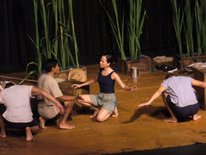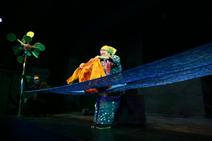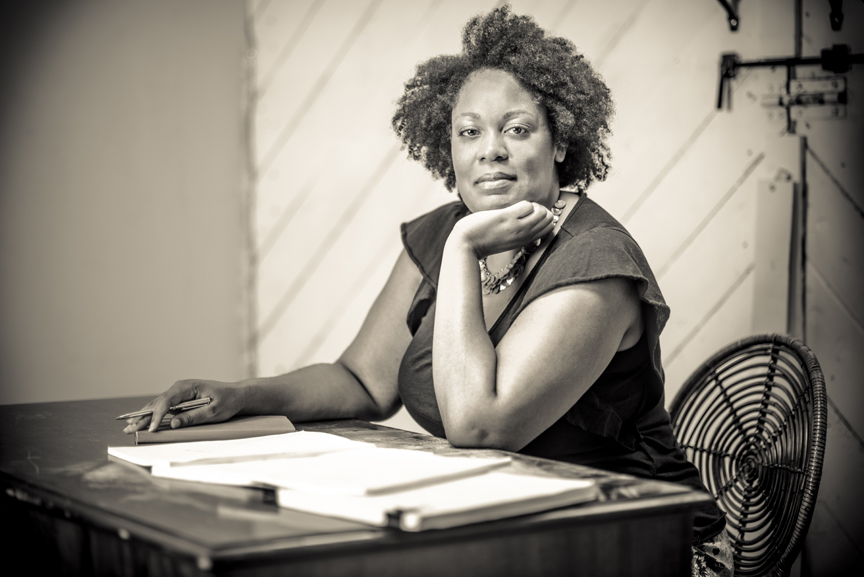|
Jacqueline Lawton: Give us a little background on where you’re from originally, where you grew up, and how you ended up where you are now…
Maile Holck: I was born in Fort Leavenworth, Kansas. My father, who was originally from Hawaii, was in the army at the time and was stationed there. We moved back to Hawaii to a town called Mililani on the island of Oahu when I was two years old and that is where we stayed – and where my mom is to this day. Mililani is a suburb of Honolulu made up of young local families, military families and aging empty nesters. It was a lovely place to grow up, but I couldn’t wait to go away to college – “get off the rock” as it were – and see what else the world had to offer, so when I turned 18 I left believing I would never return except to visit family. And that is exactly what I did for most of my adult life. I went to college at the University of Northern Colorado where I majored in Theatre with a minor in Women’s Studies. Immediately upon graduating, I moved to New York City. I knew nothing of what it took to make it as an actor and spent the majority of my time there working to play and pay the rent. After four years I decided to go back to school to pursue an MFA and was accepted to the University of Washington’s Professional Actor Training Program. Again, immediately upon graduating, I moved to New York City, but this time I had a little more “know how,” a little more confidence and a lot more training, and pretty quickly found myself working as a professional actor in the regional theatre world. Almost just as quickly it seemed, I began to question what it was I was doing with my life. When I was fortunate enough to get hired, I was speaking other people’s words and telling other people’s stories. Even the way in which the story was told was up to the director. As an actor, I began to feel quite powerless. One question in particular kept popping into my head: “To what end?” It was a question a professor in grad school used to ask us over and over again in regard to choices we made during our scene study class, and in the case of my life, I didn’t have a good enough answer. So I left the theatre – a couple of times – seeking a different way of life, but inevitably found myself back working – and at my best whole self – in the theatre. After six years of this kind of back and forth, I felt I was floating without any real direction. Then my father’s health suddenly took a turn for the worst and it became obvious that the direction I needed to move toward was home. In 2008 I moved home to help take care of my dad. For work I decided to audition for the only professional theatre company in the islands – Honolulu Theatre for Youth – and landed a job as a full time actor and part time teaching artist with the company. I still work for HTY, though now primarily as an actor, and have found it to satisfy – for now at least – that one question in particular, “to what end?” HTY is one of the most rewarding and challenging places I have ever worked. I never would have imagined when I left the islands at 18 that my journey would lead me right back where I began, but I am so very grateful it did. JL: Why did you decide to get into theater? Was there someone or a particular show that inspired you? MH: When I was in the second grade the local junior high band came to play a concert at our school. I don’t remember what music they played exactly, but I do remember being incredibly moved by it. I felt my senses lift and while I’m not sure I was able to articulate it at that young age, I knew somewhere in my heart that I wanted to be able to do that – move people in such a way. For a time I thought I would go into music, but it quickly became clear that I had virtually no musical talent! I think it was in junior high when we went on a field trip to see a high school production of Fiddler on the Roof and once again, I was moved to a point of feeling the need to do the same for others. In high school I joined an after school drama program and have been doing theatre ever since. JL: What is unique about being an artist where you live? MH: Hawaii is made up of an incredibly diverse population. Historically, the people from different cultures who came to the islands worked together and supported each other out of necessity and it is through that need that the cohesiveness in which we live today grew. That said, most of the people who live here are people of color and while it’s not perfect, there is for the most part a real sense of being in it together. People are proud of their cultural identity, but are also open to and inclusive of the many other cultures that surround them so that when a play is being cast, race plays only a small role in the process. A perfect example of this is the cast of a play we recently did at HTY called The Lion Dancer. It was about a Chinese boy and his father coming to terms with accepting each other for who they were – and the old and new ways of doing things. The father was played by a Chinese man, the son was played by a Filipino man and the two friends of the boy were played by a man who is half Hawaiian and half African American and by me who is Japanese, Hawaiian, Norwegian and Scottish! Casting like this might not fly on the mainland, but here…we do things differently. Our cultural diversity is a huge part of what makes being an artist in Hawaii unique. JL: You are an actor, writer and teaching artist at Honolulu Theater for Youth. How did you get involved with this organization? What keeps you there? MH: When I decided to move home from New York I began researching theatres in Hawaii only to discover that HTY was the only professional theatre organization in the islands. While this surprised me, I was not deterred – I felt it presented the perfect combination of creativity and meaning I had been searching for. The fact that they hired actors for an entire season as opposed to on a show by show basis didn’t hurt either! The idea of having work as an actor for an entire season was unheard of anywhere else as far as I knew, and so I emailed the Artistic Director, Eric Johnson who invited me to attend their annual auditions. I had also been in touch with Dan Kelin, the Education Director of HTY who I remembered from workshops he conducted with the after school program I was a part of in high school. While he didn’t remember me, he was very helpful in directing me toward contacting Eric. My initial thought was that I could be both a company actor and teaching artist – I thought the two went hand in hand, but Dan informed me that I had to choose one or the other, because the schedules of each department were so rigorous there was virtually no room for crossover. In my first season, however, an opportunity for crossover presented itself and I was able to shift over to the education department after my portion of the season was finished. I’ve had little opportunity to cross over since then, but there are conversations going on between the artistic and education departments about how to make those opportunities occur more often. I’ve been fortunate in that HTY has been willing to take me back with each new season, but regardless of that, I have always questioned whether or not I should stay or go. I have always decided to stay. I stay because it challenges and stretches me as a creative person. I stay because I believe the work we do is valuable to the children and communities of Hawaii. I stay because HTY and the people who work there have become my home and my family. That doesn’t mean I’ll stay forever – they probably wouldn’t want to keep me forever! – but for now I know it’s exactly where I’m supposed to be. JL: During the conference, you mentioned that you were working on a solo performance piece. Can you tell us a bit about it? MH: The show I’ve been writing came out of a piece – a solo piece – I wrote in grad school. I decided to revisit it after touring a play to high schools called Girl’s Choice. Girl’s Choice is part of a program called Respect is a Choice about sexual violence and date rape. There are two parts to it: Girl’s Choice and Boy’s Choice. Each tells the same story but from different perspectives – the boy’s and the girl’s. The girl’s piece is done for an audience made up solely of girl’s – even the adults in the room must be female – and the boy’s piece is done for an audience solely of boy’s. Each play runs about 25 minutes and is followed by discussion. It was during one of our first discussions that we asked the girls if they ever felt pressure to be sexually active. The vast majority of them said no. We then clarified the question by saying the pressure didn’t necessarily have to come from another person, but that it could come from other sources such as media, music, television or movies. This created some pause, and sometimes the girls would talk about the sex and violence so prevalent in the music, television and movies of today, but I felt there were more insidious images and messages out there that the girls were reluctant to admit to or were simply unaware of. The piece I wrote in grad school only touched on this topic, but after getting virtually the same reactions time after time in our discussions, I decided to revisit it and revamp it so that it spoke directly to the notion that we’ve become such a passive audience that we don’t question the images and messages we see every day. My hope is that it will help young women – and men for that matter – to view the world around them with a more critical eye. JL: Who nominated you to be a Young Leaders of Color Award Recipient? MH: HTY’s Artistic Director, Eric Johnson. He is and has always been such a supporter and believer in many of the artists who come through HTY’s doors. He challenges us – and himself – to stretch ourselves beyond our comfort zones and reach for our fullest potential in every project we work on. JL: What excited you most about taking part in the conference and the program? MH: The opportunity to simply be in the room and talk with theatre folks from across the country was enough to thrill me. The connections I made, the conversations I had and the inspiration I felt coming out of the conference and program was truly humbling – and exciting and motivating! JL: What was the most valuable lesson you learned from the conference? MH: Being surrounded by so many theatre people with big ideas and opinions forced me to recognize my own tendency toward complacency. I have a pretty good life here in Hawaii and at HTY, but if I am going to call myself an artist and accept the role of “Young Leader of Color” I have to challenge myself to go beyond what is comfortable. Ask bigger and more difficult questions. Not only of myself, but of my entire community. JL: What are some of the challenges you have faced as an artist of color? What have you learned from these experiences? MH: Coming from Hawaii – where most of us are people of color – I didn’t identify myself as a person of color until I moved to the mainland, and I didn’t experience any real challenge being an artist of color until I began working professionally as an actor. People in the industry, it seemed, needed to label me. Was I Asian? Hispanic? What kind of a name is Maile? I was told once that I should consider changing my name because it was too “exotic” and might keep me from being called in for certain roles. I never did change my name and what I learned ultimately from those experiences is that if you want to work and you don’t want to be beholden to other people’s perceptions of who they think you are – or who they need you to be to make their lives easier and more comfortable – then you need to either move someplace where you can achieve that (like Hawaii!) or you need to make your own work. One thing I’ve done, one thing I’m working on. JL: What advice do you have for other young artists of color in the theatre? MH: This was a lesson I only recently learned, but I would tell other young artists of color that the power is within them to create change. Find a community of other like-minded artists and well…create! You cannot always wait for someone to hire you – this was one of my biggest struggles and lessons in New York as an actor. Also, you can do your art anywhere. Anywhere. Even on a little island in the middle of the Pacific Ocean. JL: What’s up next for you and where can keep up with your amazing work? MH: We will be starting rehearsals for HTY’s 2012/2013 season in mid July – you can keep up with us at our website www.htyweb.org. Also, continue to work on my play which I hope to perform in high schools and colleges in Hawaii. Someday soon I’ll have a website on which you will be able to find out more about this and many more projects I’ll be working on!
0 Comments
Your comment will be posted after it is approved.
Leave a Reply. |
My BlogI'm a playwright, dramaturg, and teaching artist. It is here where you'll find my queries and musings on life, theater and the world. My posts advocate for diversity, inclusion, and equity in the American Theatre and updates on my own work. Please enjoy!
Categories
All
Archives
June 2020
Reading List
|



